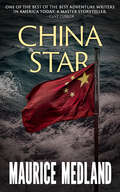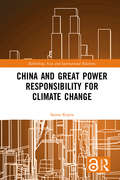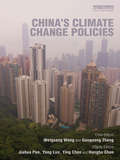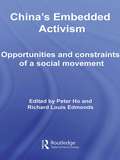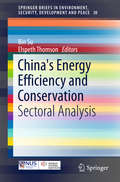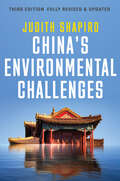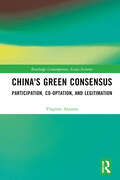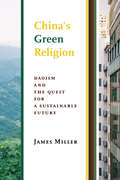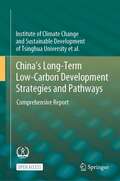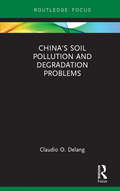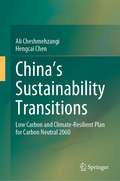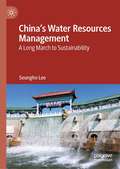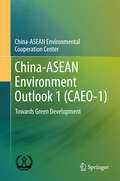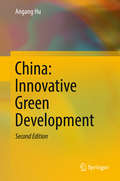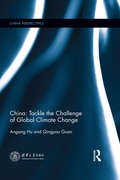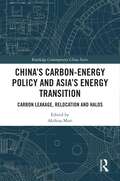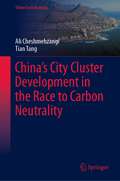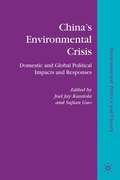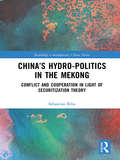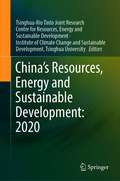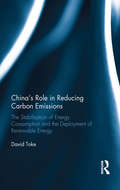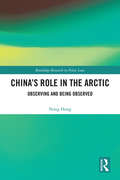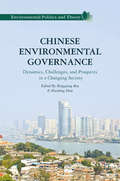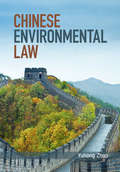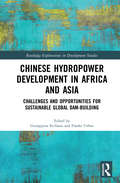- Table View
- List View
China Star
by Maurice MedlandAn ex-navy officer performs a daring sea rescue in this international thriller from &“one of the best adventure writers today. A master storyteller.&” (Clive Cussler, #1 New York Times–bestselling author of the Dirk Pitt adventure series) When Elizabeth Grayson stumbles upon confidential intel while doing medical research in China, her quiet life turns to terror. Imprisoned in a labor camp on an isolated island, the senator&’s daughter struggles with her horrifying new knowledge that China is planning an attack against the United States. Worse, scientific advances in her own work may have helped make China&’s powerful new weapon against America possible. Matt Connor&’s location on a salvage boat in the Pacific Ocean may have landed him the lucrative job of rescuing a politician&’s daughter from prison, but once the ex-navy officer has Elizabeth Grayson on his ship, he&’s bound with her in a deadly game of survival. With the Chinese government determined to launch a weapon of mass destruction before their secret offensive is revealed, both Matt and Elizabeth&’s lives are on the line—along with the fate of the American people. &“. . . a thrilling novel of international intrigue . . . A tense and riveting adventure from cover to cover.&” —Midwest Book Review
China and Great Power Responsibility for Climate Change (Rethinking Asia and International Relations)
by Sanna KopraAs American leadership over climate change declines, China has begun to identify itself as a great power by formulating ambitious climate policies. Based on the premise that great powers have unique responsibilities, this book explores how China’s rise to great power status transforms notions of great power responsibility in general and international climate politics in particular. The author looks empirically at the Chinese party-state’s conceptions of state responsibility, discusses the influence of those notions on China’s role in international climate politics, and considers both how China will act out its climate responsibility in the future and the broader implications of these actions. Alongside the argument that the international norm of climate responsibility is an emerging attribute of great power responsibility, Kopra develops a normative framework of great power responsibility to shed new light on the transformations China’s rise will yield and the kind of great power China will prove to be. The book will be of interest to students and scholars of international relations, China studies, foreign policy studies, international organizations, international ethics and environmental politics.
China's Climate Change Policies
by Jiahua Pan Wang Weiguang Guoguang ZhengChina is becoming a rising star in global economical and political affairs. Both internationally and within China itself, people have great expectations of its future role. This book aims to clarify many aspects of China’s key position in the climate change situation and policy debates. However, limited by its development stage, natural resource endowment, and other unbalanced developing issues, China is still a developing country. This book shows the reader the real China, which can provide more comprehensive solutions for future global climate regimes. This book includes research into China’s twelfth Five-Year-Plan; low-carbon city pilot schemes; policies and pathways for China’s nationally appropriate mitigation actions; China’s forestry management; China’s NGOs and climate change; the low-carbon 2010 Expo in Shanghai; carbon budget proposals; China’s green economy and green jobs; China’s reaction to carbon tariffs; China’s actions in approaching adaptation; China’s cumulative carbon emissions, and more. China’s Climate Change Policies brings together experienced experts with in-depth understanding of the scientific assessment of climate change and relevant social and economic policies, and senior experts who have participated directly in international climate negotiations. This will help the reader to better understand the 2011 Durban climate change conference, as well as China’s long-term strategy in response to climate change.
China's Embedded Activism: Opportunities and constraints of a social movement (Routledge Studies on China in Transition)
by Peter Ho Richard Louis EdmondsIn recent years China has been remarkable in achieving extraordinary economic transformation, yet without fundamental political change. To many observers this would seem to imply a weakness in Chinese civil society. However, though the idea of democracy as multitudes of citizens taking to the streets may be attractive, it is simultaneously misleading as it disregards the nature of political change taking place in China today: a gradual shift towards a polity adapted to a pluralist society. At the same time, one may wonder what the limited political space implies for the development of a social movement in China. This book explores this question by focusing on one of the most active areas of Chinese civil society: the environment. China’s Embedded Activism argues that China’s semi-authoritarian limitations on the freedom of association and speech, coupled with increased social spaces for civic action has created a milieu in which activism occurs in an embedded fashion. The semi-authoritarian atmosphere is restrictive of, but paradoxically, also conducive to nationwide, collective action with less risk of social instability and repression at the hand of the governing elite. Rich in case studies about environmental civic organizations in China, and written by a team of international experts on social movements, NGOs, democratization, and civil society, this book addresses a wide readership of students, scholars and professionals interested in development, geography and environment, political change, and contemporary Chinese society.
China's Energy Efficiency and Conservation: Sectoral Analysis (SpringerBriefs in Environment, Security, Development and Peace #30)
by Bin Su Elspeth ThomsonThis Brief identifies various aspects of energy challenges faced by the Chinese central/local governments, and also provides an opportunity to study how best to achieve green growth and a low-carbon transition in a developing country like China. The progress of China's carbon mitigation policies also has significant impacts on the on-going international climate change negotiations. Therefore, both policymakers and decision makers in China and other countries can benefit from studying the challenges and opportunities in China's energy development.
China's Environmental Challenges (China Today Ser.)
by Judith ShapiroChina’s huge environmental challenges affect not only the health and well-being of China but the very future of the planet. In this fully revised and updated third edition of her acclaimed book, noted scholar of Chinese environmentalism Judith Shapiro explores China’s struggle to achieve the ‘ecological civilization’ championed by Xi Jinping since 2017. Drawing on six core analytical concepts - globalization, governance, national identity, civil society, environmental justice, and extractivism - Shapiro ably demonstrates the multifaceted and complex nature of this struggle. China’s precipitous economic growth has carried a heavy cost in air and water pollution, soil contamination, and loss of habitat for the biodiversity upon which human life depends. But its quest for sustainability has been further hampered by authoritarian governance patterns, soaring middle class consumption, the need to provide employment and safety nets for a population of more than one billion, and a manufacturing sector thirsty to secure global resources and sell to new markets. Transformation to a more sustainable development model is still possible. But, as Shapiro persuasively argues, this will require humility, creativity, and a rejection of business as usual. China – and the planet – are at a pivotal moment.
China's Green Consensus: Participation, Co-optation, and Legitimation (Routledge Contemporary Asian Societies)
by Virginie ArantesDespite contrasting approaches, democratic and authoritarian governments all underline the fact that environmental protection is crucial and inevitable—and China’s enthusiasm in stepping up its efforts to protect the environment has not gone unnoticed. This book highlights how the consensual orchestration of sustainability in China’s biggest city, Shanghai, affects non-state actors’ ways of perceiving, acting, and organizing around environmental issues. China’s Green Consensus examines grassroots realities as they intersect with events of everyday life, offering insights into areas that far transcend debates over coercive forms of environmentalism and exploring the “soft” and “green” facets of President Xi Jinping’s authoritarian approach to governance. The importance of environmental protection in people’s lives serves as a lens to analyze and understand authoritarian adaptations to environmental global phenomena. Arantes highlights how, through mobilization and (de)politicization, a “green” consensus leads to the displacement of state responsibilities and the cultivation of civil society in its own image. In so doing, she opens up new ways of thinking about the complexities of environmental governance, consensus politics, subject making, and citizenship in authoritarian contexts. This book will be of interest to scholars and students of Chinese society and politics, environmental politics, political ecology, international relations, and urbanization in Asia, as well as all others interested in the rising appeal of authoritarianism around the globe.
China's Green Religion: Daoism and the Quest for a Sustainable Future
by James MillerHow can Daoism, China's indigenous religion, give us the aesthetic, ethical, political, and spiritual tools to address the root causes of our ecological crisis and construct a sustainable future? In China's Green Religion, James Miller shows how Daoism orients individuals toward a holistic understanding of religion and nature. Explicitly connecting human flourishing to the thriving of nature, Daoism fosters a "green" subjectivity and agency that transforms what it means to live a flourishing life on earth.Through a groundbreaking reconstruction of Daoist philosophy and religion, Miller argues for four key, green insights: a vision of nature as a subjective power that informs human life; an anthropological idea of the porous body based on a sense of qi flowing through landscapes and human beings; a tradition of knowing founded on the experience of transformative power in specific landscapes and topographies; and an aesthetic and moral sensibility based on an affective sensitivity to how the world pervades the body and the body pervades the world. Environmentalists struggle to raise consciousness for their cause, Miller argues, because their activism relies on a quasi-Christian concept of "saving the earth." Instead, environmentalists should integrate nature and culture more seamlessly, cultivating through a contemporary intellectual vocabulary a compelling vision of how the earth materially and spiritually supports human flourishing.
China's Long-Term Low-Carbon Development Strategies and Pathways: Comprehensive Report
by Institute of Climate Change and Sustainable Development of Tsinghua University et al.This open access book introduces a multi-disciplinary and comprehensive research on China's long-term low-carbon emission strategies and pathways. After comprehensively considering China’s own socioeconomic conditions, policy design, energy mix, and other macro-development trends and needs, the research team has proposed suggestions on China’s low-carbon development strategies and pathways until 2050, with required technologies and policies in order to realize the goals of building a great modern socialist country and a beautiful China. These achievements are in conjunction with the climate goals set in the Paris Agreement alongside Global Sustainable Development. The authors hope that the research findings can serve as a reference for all sectors of Chinese society in their climate research efforts, offer support for the formulation and implementation of china’s national low-carbon development strategies and policies, and help the world to better understand China’s story in the general trend of global green and low-carbon development.
China's Soil Pollution and Degradation Problems
by Claudio O. DelangChina’s air pollution is infamous. The haze can make it impossible to see buildings across the street, and the pollution forces schools to close and creates health and morbidity problems, in addition to tremendous environmental degradation. However, China also faces another important environmental problem, which is less well-known to the public: that of soil degradation and pollution. This book provides an overview of the problems related to soil degradation and pollution throughout China, examining how and why current policy has fallen short of expectation. It also examines the challenges faced by policy makers as they attempt to adopt sustainable practices alongside a booming and ever-expanding economy. China's Soil Pollution and Degradation Problems utilizes grey literature such as newspaper articles, NGO reports and Chinese government information alongside academic studies in order to provide an extensive review of the challenges faced by grassroots organizations as they tackle environmental policy failings throughout China. This book will be of great interest to students of environmental pollution and contemporary Chinese studies looking for an introduction to the topics of soil pollution and soil degradation, and for researchers looking for an extensive list of sources and analysis of China's environmental problems more broadly.
China's Sustainability Transitions: Low Carbon and Climate-Resilient Plan for Carbon Neutral 2060
by Ali Cheshmehzangi Hengcai ChenThis book considers the impact of global climate change, advocating to promote sustainable development from the perspective of low carbon and climate resilience, by reducing carbon emissions in different aspects of urban and regional development. As the world's largest emitter of carbon dioxide, China is continuously exploring a sustainable path to achieve the momentous goal of 2060 carbon neutrality. In addition, this book reviews and summarizes China's green development and predicts the transformation of China's carbon emission and energy structure before and after the peak of carbon emission in 2030. It examines the role of governance in decarbonization efforts, focusing on decision making processes, policies and regulations, as well as the significance of regions, cities, and communities. This book highlights typical methods of implementing and achieving low carbon development in light of China's practical situation, which helps to resolve some of the problems that may arise in achieving the carbon neutral goal. Therefore, this book is suitable for the reference of scholars in low-carbon environment science, sustainable urban development, and other related fields. It also provides inspiration for China's medium and long-term sustainable development plans in the future.
China's Water Resources Management: A Long March to Sustainability
by Seungho LeeThis book investigates water resources management and policy in China over the last two decades with a core focus on the role of water for socioeconomic development and sustainability. Recent policies, such as the Three Red Lines and the Water Ten Plan are evaluated for sustainable water supply, use and quality control. The book appraises solutions through demand management, water rights and pollution trading, virtual water and water footprint. Supply management is discussed taking examples from the Three Gorges Dam and the South North Water Transfer Project. The water market is investigated uncovering the active engagement of the private sector and includes discussions on how transboundary rivers demonstrate China’s engagement with its riparian countries for benefit sharing. This book will be an invaluable reference for researchers in the field as well as practitioners and students who have an interest in water and development in China.
China-ASEAN Environment Outlook 1 (CAEO-1)
by China-ASEAN Environmental CooperationThis book presents a comprehensive analysis of the status and progress of China-ASEAN green development and examines the common development issues in China and ASEAN Member States (AMSs). It also explores development trends within the framework of global and regional environmental governance and discusses the approaches towards green development in China and AMSs, offering its own definition of green development and using a “pressure-state-response” (PSR) model to build a framework for assessing green development. The book includes typical policy measures and numerous practices for green development in China and AMSs in the form of tables, figures and boxes. Based on detailed analysis, it argues that the global 2030 Agenda for Sustainable Development brings significant opportunities to China and AMSs, that the ongoing pragmatic cooperation should be further advanced, and that a connection between the Belt and Road Initiative and green ASEAN Community should be established to achieve regional sustainable development. As such it furthers readers’ understanding of environment and development and practical policy advice for promoting China-ASEAN cooperation on environment and green development. Intended for decision makers from the government, business sector, and civil societies who are working to boost green development and China-ASEAN cooperation, it is also a valuable resource for government officials, researchers and non-experts interested in creating a balanced relationship between the environment and development.
China: Innovative Green Development
by Angang HuThis book is particularly concerned with China s path to green development and how it can be understood, exploring questions such as how the goal of Chinese-led green development can be achieved. The book provides systematic explanations of the theory of green development, exploring its background, its theoretical basis, the areas it covers, the stages it encompasses and the constraining and favorable factors involved. We see how humankind is at a period of transition from the traditional black industrial civilization to a modern green ecological civilization. The author gives a profound critique of the traditional Western model of development, provides a comprehensive analysis of the crisis and the opportunities presented by green development and depicts the grand goal of green modernization in a creative, bold, forward-looking manner. A three-step strategy to design and promote green development is proposed. Readers will discover why China must become an innovator, practitioner, and leader of green development, and how green planning is an important means to establish green development. The book explores how local governments can become green innovation practitioners, and how enterprises can become the main arena of green development. This book is a creative and innovative work that will appeal to scholars interested in the long-term development of humankind in general and China in particular. It also serves well as a green development textbook, presenting related scientific knowledge and important information for decision-making in a concise, easy-to-understand form. "
China: Tackle the Challenge of Global Climate Change (China Perspectives)
by Angang Hu Qingyou GuanGlobal climate change is one of the challenges ever to confront humanity with the largest scale, widest scope and most far-reaching influence. As the biggest developing country with the largest population, China is the world’s leading consumer of coal and energy, and one of the worst-hit victims of global warming. Consequently, China should assume its responsibility in making contributions to global sustainable development. Based on the principles of fairness and efficiency, this study creatively puts forward two principles of global governance on climate change. The first entails replacement of the two-group schema of developed and developing countries with a four-group model based on the Human Development Index (HDI). The second entails application of the resulting model to specify the major emitters as principal contributors to emission reduction. In addition, it proposes a two-step strategy for China to tackle the issue of climate change. This book makes it clear that China should proactively engage in relevant international cooperation, actively participate in international climate negotiations, make clear commitments to reduce emissions, and assume the obligations of a responsible power to achieve sustainable and green development.
China’s Carbon-Energy Policy and Asia’s Energy Transition: Carbon Leakage, Relocation and Halos (Routledge Contemporary China Series)
by Akihisa MoriThis book seeks to examine the impacts associated with China’s carbon-energy policy in Asia and how, coupled with the Belt and Road Initiative, these effects prompt foreign direct investments in coal power and exports of renewable energy technologies. China shows a co-evolution of carbon-energy policy and energy transitions from coal to renewables. Assessing how the policy intensifies pressures and motivations to Chinese companies, chapters in this edited volume analyse how the policy has changed energy and CO2 emissions in Asia through the lens of carbon leakage, relocation, and halos. Contributors present in-depth studies on China’s investments and exports, and also its impacts on Indonesia, India, Vietnam and Japan. Using applied computable general equilibrium and scenario input-output analyses, chapters investigate if regional electricity connectivity reduces new coal power investments through efficiency gain. Arguing that China is shifting from the world’s factory to the leading innovator and Asia's demand centre, it is ultimately demonstrated that China is likely to achieve climate targets whereas Asia to increase CO2 emissions and economic reliance on China. China’s Carbon-Energy Policy and Asia’s Energy Transition will be of significant interest to students and scholars of energy, environment, and sustainability studies, as well as Chinese studies and economics.
China’s City Cluster Development in the Race to Carbon Neutrality (Urban Sustainability)
by Ali Cheshmehzangi Tian TangThe scope of this book is to map China’s city clusters and their individual directions for the national-level strategies in line with the 2060 carbon neutrality plan. Since China announced the carbon neutrality plan in autumn 2020, no study has looked at the role of city clusters in achieving this long-term plan. Hence, this study is believed to be the first attempt to explore this important topic from the city cluster perspective. It explores the challenges, opportunities, and directions of all 19 city clusters, allowing readers to have a clear picture of China’s historical and ongoing progress, as well as the challenges and opportunities that lie ahead. In a short time, China’s city clusters have helped boost regional economic development, infrastructure development, trade and business, and better urban–rural integration. With enhanced coordination of connection and transport networks in and between the city clusters, we see a growing number of initiatives beyond just the initial economic strategies. The dual approach of top-down policies and infrastructure systems and bottom-up governance and investments has helped China consider urban–rural development strategies and regional sustainable development. These factors are essential to be explored from the city cluster perspective and in line with China’s sustainable development and carbon neutrality directions. Hence, the book covers these points holistically, ensuring that regional planning and development are favored in the face of uneven urbanization trends.We anticipate this book to be a valuable resource for local governments and authorities, urban planners and practitioners, developers, and urban researchers. While the focus is on China’s city clusters, we believe there are similar examples elsewhere. Hence, lessons learnt from this book could apply to other countries, regions, and subregions. Lastly, the book aims to put regional sustainable development at the heart of longer-term strategies and plans, such as the case of China’s carbon neutrality plan.
China’s Environmental Crisis
by Sujian Guo Joel Jay KassiolaThis path-breaking collection covers the significance of China's extreme environmental challenges for both Chinese society and the world, how these challenges are impacting domestic Chinese society and its political institutions, and how these institutions are responding in their efforts to address the environmental problems.
China’s Hydro-politics in the Mekong: Conflict and Cooperation in Light of Securitization Theory (Routledge Contemporary China Series)
by Sebastian BibaChina’s Hydro-politics in the Mekong explores the intricate processes of conflict and cooperation over the use of water resources in the Mekong river basin between upstream China and the downstream countries of Laos, Thailand, Cambodia, and Vietnam. The book tackles two gaps in the empirical literature: first, the neglect of international hydro-politics as one specific and increasingly important issue area of China’s foreign policy behavior, especially its neighborhood diplomacy; and second, the disregard of China’s role in Mekong River politics. In particular, this book scrutinizes the ‘spring 2010 Mekong crisis’ and the events surrounding it which led to a series of complex multi-level, security-related interactions among various state and non-state actors in the region, with China at the center. Analyzing this crisis, the book not only employs securitization theory as its theoretical framework and adds a couple of innovations to this theory, but also gives a detailed account of China’s hydro-political behavior in one specific and particularly revealing case study. Moreover, the book embeds China’s Mekong hydro-politics in the bigger picture of its (sub-)regional international affairs, as the former does not take place in a vacuum, but rather is a part of China’s overall foreign relations with its neighbors. The book acknowledges this link and provides new insights into the role of hydro-politics and its relationship vis-à-vis other issue areas of China’s foreign policy.
China’s Resources, Energy and Sustainable Development: 2020
by Tsinghua-Rio Tinto Joint Research Centre for Resources, Energy and Sustainable Development Institute of Climate Change and Sustainable Development, Tsinghua UniversityThis book explores sustainable development from the perspective of resources and energy, based on China’s practical experience and cross-disciplinary research. It focuses on major challenges, key solutions and policy recommendations, and studies and explores seven important themes of resources, energy and sustainable development, including: 1) China’s low-carbon energy transition, 2) China’s urbanization and low-carbon development, 3) China’s low-carbon action in cities, 4) China’s low-carbon power transition, 5) China’s water resources management, 6) electric vehicle development and key metal resources and 7) China’s low-carbon development of the iron & steel industry. This book contributes to a more integrated understanding of many themes and their relationships in the area of resources, energy and sustainable development and guides the related policy and management.
China’s Role in Reducing Carbon Emissions: The Stabilisation of Energy Consumption and the Deployment of Renewable Energy
by David TokeChina, a still developing economy comprising a fifth of the world’s population, will play a key role in the global movement towards reducing carbon emissions. The aims of the Paris Agreement may stand or fall with China, both for its own contribution and the example it will set the developing world. China’s Role in Reducing Carbon Emissions discusses the prospects for China achieving radical reductions in carbon emissions, within the context of the current economic and political landscape. With a particular focus on technologies such as such as wind power, solar power and electric vehicles, Toke examines how China is transitioning to a state of stable energy consumption via a service-based economy and heavy investment in non-fossil energy sources. The book concludes that China may be set to reduce its carbon emissions by approximately two-thirds by 2050. This book is a valuable resource for students and scholars of climate change, sustainable development, political science and energy, as well as energy professionals seeking to understand the implications of recent developments in China.
China’s Role in the Arctic: Observing and Being Observed (Routledge Research in Polar Law)
by Nong HongThis book explores the growing interests of China in the Arctic and examines the nature of its interests and motivations in maintaining its involvement and presence in the region. The new geopolitical landscape of the Arctic today is a significant departure from the great power politics that existed in the region during the Cold War era. Apart from traditional Arctic states, more and more international organizations and non-Arctic states are showing an increased interest in this region, not least China. Many have attempted to interpret China’s intention in moving to the high north and this book aims to add to the existing literature from three approaches: China’s participation in the international institutions, China’s relationships with the Arctic stakeholders and China’s sectoral engagement in the Arctic. In taking a three-dimensional approach to the analysis, the author builds a comprehensive picture of China’s interests and activities in the Arctic, not only from the perspective of China but also from the viewpoint of other Arctic states (Russia, Canada, the U.S., Norway, Sweden, Denmark, Finland and Iceland). One of the first books in English to cover the subject since the release of China’s Arctic policy white paper in January 2018, this analysis will be of interest to academics, students of Arctic studies, maritime law and international law, as well as policy makers in Arctic and non-Arctic states.
Chinese Environmental Governance: Dynamics, Challenges, and Prospects in a Changing Society (Environmental Politics and Theory)
by Bingqiang Ren Huisheng ShouThis book offers the most updated research on the dynamics, challenges, and prospects in China's environmental governance.
Chinese Environmental Law
by Yuhong ZhaoSince the economic take-off of the 1980s, China has undertaken industrialization and urbanization at unprecedented scale and speed. As it became the world's second largest economy, the burden of pollution has reached the limits of nature's carrying capacity. Chinese Environmental Law provides a comprehensive, structured and up-to-date analysis of the increasingly sophisticated Chinese environmental law regime. It examines the statutory regulation of pollution in detail, covering key environmental statutes, policies and plans, and investigates judicial innovation in the interpretation and application of environmental legal instruments. The book presents Chinese environmental law in action and in context. By discussing key institutions and processes, readers gain exposure to the operation of Chinese environmental law and the dynamic interactions among different institutions, both state organs and non-governmental organizations. The unique socio-economic and political context presents special challenges to the implementation and enforcement of environmental law in China.
Chinese Hydropower Development in Africa and Asia: Challenges and Opportunities for Sustainable Global Dam-Building (Routledge Explorations in Development Studies)
by Frauke Urban Giuseppina SicilianoIn recent years, both Chinese overseas investment and hydropower development have been topics of increasing interest and research, with Chinese actors acting as financiers, developers, builders and sub-contractors. Chinese Hydropower Development in Africa and Asia explores the governance and socio-economic implications of large Chinese dams’ development in low- and middle-income countries in Asia and Africa and asks how these big infrastructure projects promote sustainable local and national development in the recipient countries. The book first discusses general aspects of Chinese involvement in hydropower development in Africa and Asia, looking at political and economic aspects, before presenting selected case studies from large dams built and financed by Chinese actors in Asia and Africa. Based on these results, the book further makes recommendations on how to improve the planning, implementation and governance of large dams for sustainable global dam-building. This volume is a valuable resource for academics, researchers and scholars in the areas of Development, Environmental Studies, Politics and Economics.
